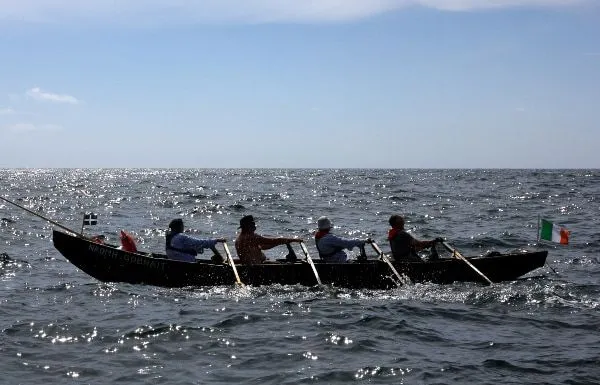Eye For Film >> Movies >> The Camino Voyage (2017) Film Review
The Camino Voyage
Reviewed by: Jennie Kermode

In the days before motorways – before even roads – the fastest way to get anywhere was in a boat, travelling by river or along the coast. Tiny boats made from simple materials were a key part of trade, diplomacy, warfare and exploration. The Celtic naomhóg was canoe-like in shape, thin-sided and supported by stout wooden ribs, sealed with tar. It was equipped with a sail for use when the wind was favourable, but predominantly manoeuvred using multiple pairs of oars. These days, no-one really needs to use a naomhóg, but there’s value in preserving old skills. There’s also a certain appeal to pitting one’s skills against those of one’s ancestors, especially if one appreciates the very real risks involved.
The Camino Voyage follows a small crew who have built their own naomhóg as they take it on a pilgrimage to the shrine of the apostle St James in the cathedral of Santiago de Compostela in A Coruña. Whilst Ireland to northern Spain might seem a manageable distance – not as risky as the voyage of the Kon-Tiki, for instance – there are some dangerous waters en route and no guarantee of clement weather. The men have limited sailing experience. Over the course of their journey they will encounter multiple challenges and learn the hard way what their ancestors went through.

Despite the dangers of the journey, The Camino Voyage is, for the most part, a gentle, lyrical film. One of the crew members, Danny Sheehy, is a poet, and composes along the way, celebrating their bold endeavour and the landscapes they are travelling through. There are visits to ports where local people regard their undertaking with awe, and a detour in France that sees them make their way along canals, acquiring more admirers on the way. Many people are concerned and a bit startled by what they’re doing, but most seem to grasp its meaning to them, and several reflect on the importance of history. Everywhere thy go, the crew are greeted by friendly faces and generous offers of support.
As the men are aware before they set off, much of the journey will offer little stimulation – they will simply be rowing, for hours at a time, with little to look at but the water. Director Donal O’Ceilleachair captures this aspect of the voyage without ever letting the film become tedious. Instead, we see how it changes the men, how time spent entirely apart from the modern world alters their understanding of themselves. The viewer is invited, albeit briefly, to connect with this experience, out on the blue of the water with the sound of the wind and the waves.
There’s a tragic final twist to this tale, which follows the men over further, shorter voyages after their pilgrimage is complete. It adds a poignant note to a film that is altogether more compelling than you might expect. The Camino voyagers are not young men but their courage, determination and love of life show that it’s never too late to embark on an adventure.
Reviewed on: 01 Mar 2018















